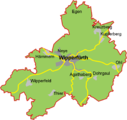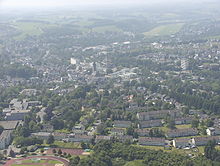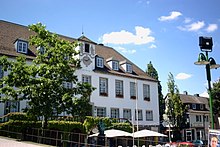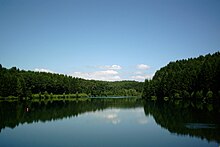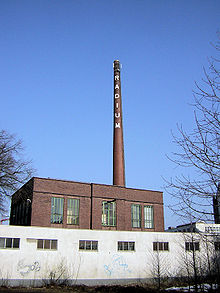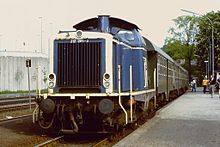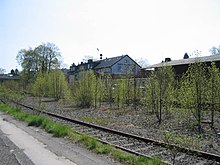Wipperfürth
| coat of arms | Germany map | |
|---|---|---|

|
Coordinates: 51 ° 7 ' N , 7 ° 24' E |
|
| Basic data | ||
| State : | North Rhine-Westphalia | |
| Administrative region : | Cologne | |
| Circle : | Oberbergischer Kreis | |
| Height : | 310 m above sea level NHN | |
| Area : | 118.3 km 2 | |
| Residents: | 20,963 (Dec. 31, 2019) | |
| Population density : | 177 inhabitants per km 2 | |
| Postal code : | 51688 | |
| Primaries : | 02267, 02268 , 02269 | |
| License plate : | GM | |
| Community key : | 05 3 74 052 | |
| LOCODE : | DE WPH | |
City administration address : |
Marktplatz 1 51688 Wipperfürth |
|
| Website : | ||
| Mayor : | Michael von Rekowski ( independent ) | |
| Location of the city of Wipperfürth in the Oberbergisches Kreis | ||
Wipperfürth is a city in the Oberbergisches Kreis in the administrative district of Cologne in North Rhine-Westphalia ( Germany ) and the oldest city in the Bergisches Land . Since March 19, 2012, Wipperfürth has been allowed to use the official addition of Hanseatic City .
geography
Wipperfürth is located about 40 km northeast of Cologne on the Wupper , which is called Wipper in the upper reaches east of the city. The neighboring communities and towns of Lindlar , Kürten , Wermelskirchen , Hückeswagen , Radevormwald , Halver , Kierspe and Marienheide border the city .
In addition to Wipperfürth, there are seven other districts: Agathaberg , Egen , Hammern , Kreuzberg , Ohl , Thier and Wipperfeld as well as 226 named locations in the 118 km² area of the city of Wipperfürth.
history
1131 to the 14th century
The oldest written mention dates from 1131. In the Siegburger Mirakelbuch the place is already referred to as an oppidum (= city). Spelling of the first mention : Weperevorthe. Between 1217 and 1222 Wipperfürth received privileges (tax exemptions) from Archbishop Engelbert I of Cologne and, after 1225, city rights from Heinrich von Limburg , Count von Berg. Wipperfürth is therefore the oldest city in the Bergisches Land. The city was administered by Count Adolf V in 1283 . Wipperfürth had its own city court, and consultations took place at the Siegburg city court . After the distribution of offices in the Duchy of Berg , Wipperfürth-Land was administered by the Steinbach Office, which was also the seat of the courts for parishes outside the city. The city of Wipperfürth paid its taxes through the Steinbach office until 1770.
As early as 1275, King Rudolf von Habsburg allowed the Count to move his mint from Wildberg to Wipperfürth. Since then, pennies based on the Cologne model have been minted here. With the privilege of King Ludwig of Bavaria , the first groschen in Germany began to be minted in Wipperfürth in 1328 .
From the 14th century - membership in the Hanseatic League
The city had been a member of the Hanseatic League since the 14th century . The city's merchants are recorded in Stockholm , Dorpat , Malmö, Novgorod, Reval and Lübeck. The city coat of arms from 1267 shows a church in a crenellated wall. The coat of arms is based on the large town seal as it first appeared on a document from 1267, where it bears the inscription: S ( illigum ): BURGENSIUM: OPIDI: IN: WIPPERVURDE . In 1404, Wipperfürth was besieged by the people of Cologne and finally occupied, the houses of the town were set on fire by the former Krakenburg. The city wall , today's Klosterberg, also began at the Krakenburg , on the Klosterwall went past the trench to the Kölner Tor, continued to the Mahltor, from here further east between the Obergraben and the parish church, then south again to the Attendorner Tor . From there back to the monastery wall, this wall stands on the old city wall. Remnants of this city wall are still preserved on the Klosterberg and at the confluence between Untere Straße and Hochstraße (Ellers corner).
The oldest buildings in the city are the three-aisled Romanesque parish church of St. Nikolaus (around 1140) and the market fountain from 1331, which got its present form during the Renaissance . The city's development was hampered by numerous city fires: 1333; 1352; 1368; 1383; 1404; 1412; 1465 ( see also: Agathaberg ); 1511; 1585; 1795.
1806-1918
In 1806, the Duchy of Berg was ceded to Napoleon by the Bavarian King Maximilian I as Duke of Berg by way of exchange . The Grand Duchy of Berg came into being under the reign of his brother-in-law, Joachim Murat , and in 1808 Wipperfürth became the capital of a canton in the Elberfeld arrondissement of the Rhine department . The Congress of Vienna decided in 1815 to annex the Rhineland to Prussia . There were no changes with regard to the municipality and city limits . From then on, Wipperfürth belonged to the administrative district of Cologne as the district town of the Wipperfürth district and from 1822 to the Rhine province . District administrators in the new district were District Administrator Friedrich Wilhelm Schumacher (1816–1845), Julius Wiethaus (1845–1852) and Clemens Mersmann (1852–1855). There followed a dispute between the municipality of Lindlar and the city of Wipperfürth about where the seat of the new district should be located. This dispute was finally settled by the minister in 1896 .
On November 22nd, 1876, Wipperfürth got its first rail connection, from Remscheid - Lennep via Hückeswagen the Wippertalbahn ran to Wipperfürth. In 1902 this line was continued to Marienheide .
The first post bus connection in Wipperfürth was set up in 1899 to Lindlar . In 1908 there were again disputes with the community of Lindlar about the establishment of a winter school . The council of the municipality of Lindlar was of the opinion that Wipperfürth was out of the question as “Wipperfürth is at the far end of the district”. In 1909, a district administrator in Wipperfürth tried to build the winter school in Wipperfürth by decree, and all the local councils in Lindlar resigned in protest. The school was finally built in Lindlar.
On June 30, 1910, a railway connection to the Wuppertal Railway was opened after the attack. This provided a connection to the Brandenburg region to the Volmetalbahn. Originally, this line was to be continued on the Rhine to Bergisch Gladbach , but the planning was never implemented.
Before the First World War , a continuation of the Cologne-Mülheim-Lindlar railway to Wipperfürth was planned as an alternative . Because of the war, this railway was not built either.
1919-1945
On March 5, 1923, Wipperfürth was occupied by French dragoons . District administrators in the district Wipperfurth were Eduard Wessel (1919-1924) and Leo Huttrop (1924-1932). On October 1, 1932, the Wipperfürth and Mülheim am Rhein districts were merged as "Bergischer" and finally as " Rheinisch-Bergischer Kreis " with headquarters in Cologne-Mülheim . The first district administrator was District Administrator Matthias Eberhard (1932–1933).
In 1927, the plans for the Wipperfürth – Lindlar railway line were dropped in favor of the Wipperfürth – Bergisch Gladbach line.
End of the Second World War
From October 1944 so-called “ Volkssturm companies ” were set up in view of the approaching Allied troops . From February 16, 1945 to March 26, 1945, Wipperfürth was also the target of air raids, one of which was particularly striking: on March 22, 1945, an aerial bomb destroyed the town hall on the market square and an adjacent hotel.
In April 1945, German troops destroyed the Ohler Bridge to stop the advance of the Allies; NSDAP district leader Aldingen from Bergisch Gladbach gave the mayor of Wipperfürth and NSDAP local group leader Hankow the order to blow up all the dams around Wipperfürth. The command was not carried out.
On April 13, 1945, the Americans from Egerpohl and Dohrgaul entered Wipperfürth. Mayor Carl Graf, who had been removed from office by the National Socialists in 1933, was reinstated on May 7, 1945.
From 1945
With the construction of five wooden barracks at the Wipperfürth marshalling yard, a transit camp for refugees from the former German eastern regions was set up after the Second World War . In 1946, around 1,000 to 1,800 refugees arrived every day. The planning of the authorities provided for a stay of a maximum of 24 hours per person and therefore only simple equipment was provided for in terms of heating, sanitary facilities and lighting. Due to the immense influx of refugees, however, there were months of residence. It was not until 1951 and 1952 that the warehouse was renewed, the straw sack beds replaced and adequate sanitary facilities built. In 1960, the use of the barracks as a transit camp ended.
In 1955 there were plans to move the agricultural school, which had been built in Lindlar in 1910 , to Wipperfürth. But that also failed at first; it was not until 1971 that the school was moved to Wipperfürth. In 1962 a business school was established in Wipperfürth . The vocational school association with the city of Wipperfürth, the offices of Engelskirchen and Kürten and the communities of Lindlar and Klüppelberg was dissolved in 1975. The vocational school was taken over by the "Oberbergischer Kreis", which was then newly established as part of the regional reform.
In the course of the municipal reorganization , which came into force on January 1, 1975, the previous town of Wipperfürth was combined with essential parts of the communities of Klüppelberg and Wipperfeld to form the new town of Wipperfürth (Section 12 (1) of the Cologne Act ) and the newly structured Oberberg district slammed (Section 25 Paragraphs 1 and 2 of the Cologne Act).
population
On June 30, 2006, Wipperfürth had a population of 24,062. Of these, around 1,800 were foreign residents (around 7.6%). The largest groups are Turkish (around 600) and Italian citizens (around 400). Of the approximately 7,000 employees subject to compulsory insurance, 45.7% were employed in the service sector, 53.6% in manufacturing and 0.7% in agriculture. The unemployment rate in the area of the Wipperfürth employment agency (Wipperfürth, Hückeswagen and Radevormwald) was 10.5% in March 2006.
Population development
(as of December 31st)
|
Religions
According to the 2008 institutional scheme of the Archdiocese of Cologne , 12,937 Catholics live in Wipperfürth . This corresponds to a share of the population of around 55 percent.
The first Protestant community existed from the beginning of the 17th century. In 1610 it was given a church service room in the town hall. After the Spanish conquered the city in 1622, Protestants were forbidden to worship. They therefore moved to Klaswipper and Rönsahl . It was not until 1788 that the Lutherans Wipperfürth received the authority to practice their religion from the government. This was followed by the establishment of a parish that was independent of Klaswipper. In 1793 a separate church was inaugurated on the market square, but it was destroyed by the great fire in 1795. This was followed by another move to Klaswipper, where in 1837 the local church, built in the classical style, was consecrated. It was not until 1877 that today's church on the market in the main town was inaugurated. In 1891 the Wipperfürth community became independent from the community in Klaswipper. Today the Evangelical Church Community in Wipperfürth has around 3200 members. There is also an independent parish in Klaswipper.
The Daiseion-ji is one of three Nichiren-shū temples in Europe in Wipperfürth .
politics
City council
The last local election on May 25, 2014 resulted in the following distribution of the seats in the city council among the individual parties and lists:
| Political party | CDU | SPD | UWG | GREEN | FDP | LEFT | total |
| Seats 2014 | 17th | 8th | 4th | 3 | 1 | 1 | 34 |
| Seats 2009 | 17th | 8th | 5 | 3 | 3 | - | 36 |
| Seats 2004 | 19th | 8th | 4th | 2 | 1 | - | 34 |
mayor
Michael von Rekowski has been mayor of Wipperfürth ( independent ) since 2009 . He was confirmed in office with 61.98% in the mayoral election on May 25, 2014. His predecessor was Guido Forsting (CDU) from 1999 to 2009 .
coat of arms
| Blazon : “In blue above a silver ( white ) crenellated wall rising on both sideswith a three-pinned gate tower and closed black gate, a three-towered silver (white) church in side view; Above it a silver (white) shield , in it a two-tailed, blue crowned , armored and tongued red lion , covered with a four-lipped black tournament collar . " | |
| Foundation of the coat of arms: The city coat of arms is a replica of the oldest known city seal of the city. Heinrich von Limburg took over the Limburg coat of arms with the Limburg lion, but kept the well-known pewter cut in the seal. After his sons had inherited, Walram von Limburg took over the Limburg lion as the coat of arms, Adolf initially added this tournament collar to the Limburg lion as the Bergisches coat of arms, which was retained in the coat of arms until 1280. |
seal
The seal dates from 1267 and bears the inscription: "S BURGENSIUM OPIDI IN WIPPERVORDE" ; the image of the old church can be seen in the seal field.
Town twinning
-
 Surgères , Charente-Maritime , France , since 1988
Surgères , Charente-Maritime , France , since 1988
Culture and sights
Buildings
- The former Franciscan monastery Wipperfürth
- Villa Ohl (Black Powder Museum)
- Old district court , today only the tower that is integrated into the new district court can be seen.
- Old seminar on Lüdenscheider Straße, see also Engelbert-von-Berg-Gymnasium Wipperfürth
- Remains of the city wall
Buildings on the market
The Wipperfürth market square with its ensemble of buildings is well worth seeing. In relation to neighboring cities of the same size, it is also relatively busy due to the gastronomy.
- Gasthaus Penne (formerly Bergischer Hof ), old Nagelsche manor house which was built in 1699
- Old town house
- Karl-Josef-Haus (Hotel Haus am Markt)
- town hall
- Hansecafe on the market
- Brewery on the market
Buildings on the Wupper
- Old wire drawing
- Turbine house
Churches
By far the oldest church in Wipperfürth is the parish church of St. Nikolaus in the city center. The Evangelical Church is in the immediate vicinity . The foundation stone for the church building on the market square was laid on April 26, 1875, and the inauguration took place on June 6, 1877. It was built on the site of the first Protestant church, which was destroyed in the town fire of 1795. The Antoniuskirche from 1674 stands on the monastery hill. It stands on the site of the former Krakenburg and was built as a monastery church and part of the monastery complex.
There is also a Catholic church in the seven surrounding church villages of Egen , Kreuzberg , Ohl , Agathaberg , Thier , Wipperfeld , Hammern and in the Neye settlement. There are chapels in the surrounding villages, for example in Vordermühle and Niederwipper .
Mills
Parks
The “Ohler Wiesen” park has an event area for funfairs, circuses or the fire department 's Florian Day, as well as the artificial turf pitch of Vfr Wipperfürth and a large grass pitch for sporting purposes. In the past, a bridge over the Wupper led directly into the park, today it can only be reached via the old railway bridge.
freetime and sports
The city has a triple gym, several double and single gyms, sports fields , a stadium with a lawn, an indoor swimming pool with 25 meter lanes including a sauna and lawn, an airfield , tennis courts, squash courts , riding arenas and bowling alleys.
In the urban area or in the vicinity of Wipperfurth are several large dams for drinking water supply, including the Kerspe dam , Neyetalsperre , Schevelinger Dam and the Great Dhünntalsperre . The Bevertalsperre is used for flood protection and water sports, all of which are accessible for leisure activities through a network of hiking trails.
sports clubs
In the municipal sports association Wipperfürth e. V over 30 sports clubs are organized. In Neye there is a special landing field for the local air sports clubs.
Cultural event
In the culture and event center "Alte Drahtzieherei" on the Wupper, cultural events such as cabaret and music concerts take place all year round.
Economy and Infrastructure
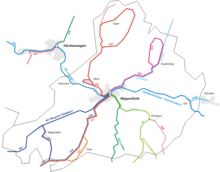
During the industrial revolution , several companies in the textile industry emerged. The electrotechnical, plastics processing, metal processing and paper processing industries are mainly based here today. The Radium incandescent lamp factory founded in 1904 is an important industrial company. Radium (now a subsidiary of Osram , which was a subsidiary of Siemens until 2013) The valve factory Voss, founded in 1931 with its fluid (pipe fittings and hydraulic valves ) and automotive (supplier and developer for the automotive industry), developed into the largest employer in the city . which is active worldwide today. Jockey Plastik is another important global company for the production of high-quality plastic packaging, which is based in Wipperfürth. In addition, there are some companies in cable production (HEW, Richter Kabel, Müller Plastik) and plastics processing (EXTE, W.Bosch, Nawrot, Polifilm ).
traffic
bus connections
Wipperfürth has bus connections to various cities in the region. These are served by Oberbergische Verkehrsgesellschaft AG , Märkische Verkehrsgesellschaft GmbH and Kraftverkehr Wupper-Sieg AG. The tariffs of the Verkehrsverbund Rhein-Sieg and Verkehrsgemeinschaft Ruhr-Lippe apply .
- Line 332: Wipperfürth – Hartegasse – Lindlar – Engelskirchen
- Line 333: Wipperfürth – Niedergaul – Frielingsdorf – Engelskirchen
- Line 336: Gummersbach – Marienheide – Wipperfürth – Hückeswagen – Remscheid-Lennep
- Line 337: Wipperfürth – Neye – Egen
- Line 338: Wipperfürth – Kupferberg – Kreuzberg
- Line 426: Wipperfürth – Thier – Kürten – Bergisch Gladbach
- Line 427: Wipperfürth – Wipperfeld – Bechen – Bergisch Gladbach
- Line 55: Wipperfürth – Kupferberg – Halver – Lüdenscheid
Autobahn connection
- Motorway 1 ( Cologne - Dortmund ) in Remscheid in 17 km, in Wermelskirchen in 18 km
- BAB 4 (Cologne- Olpe ) in Engelskirchen 18 km, in Bensberg -Moitzfeld 27 km
- BAB 45 (Dortmund - Frankfurt am Main ) in Meinerzhagen in 20 km
Federal highways
Wipperfürth lies at the intersection of the federal highways B 237 ( Remscheid - Meinerzhagen ) and B 506 (Cologne - Wipperfürth). The B 256 meets the B 237 from the direction of Gummersbach in the village of Ohl .
Airfield
In the district Neye on the Wupper there is a special airfield , the airfield Wipperfurth-Neye .
railroad
Until the 1980s, Wipperfürth had a passenger station on the Wippertalbahn Remscheid-Lennep-Hückeswagen-Wipperfürth-Marienheide. The stations Hammern, Wipperfürth West, Wipperfürth, Wipperfürth Ost, Egerpohl, Klaswipper and Ohl-Rönsahl were in the Wipperfürth area. Passenger traffic has been shut down since 1986, and all traffic since 1996. Most of the route was dismantled as a cycle and footpath by removing the tracks and applying fine gravel. The former railway line is now part of the Bergisches Panoramaradweg Wasserquintett. In March 2007, the demolition of the remaining railway tracks began. An industrial park with a grocery discounter and parking lots has been created on the old station grounds. The west bypass as an extension of the existing bypass was also completed on the old railway site.
A second railway line existed until 1960 with the Wuppertal Railway : Wipperfürth –schlag – Halver – Oberbrügge – Lüdenscheid. Here there were the stations Wasserfuhr and Kupferberg in urban areas.
Public facilities
- Federal agency for work
- District Court
- Tax office
- Youth welfare office
- Forestry Office
- Testing of TUV
- Branch of the district health office
Healthcare
The former Catholic St. Josef Hospital has been a HELIOS clinic since 2012 . It covers basic and standard care, has 194 beds and has the specialist departments of anesthesia , surgery , gynecology and obstetrics , internal medicine and an ear, nose and throat medicine department .
education
The city has a total of four secondary schools. The city. Engelbert-von-Berg-Gymnasium is located on Lüdenscheider Straße in the east of the city center and the Archbishop's St. Angela-Gymnasium is on the Silberberg in the same direction. The Hermann-Voss-Realschule and the Konrad-Adenauer-Hauptschule Wipperfürth are right next to each other on the Mühlenberg. There is also a vocational school (Bergisches Berufskolleg Wipperfürth), eight elementary schools and one special school with a focus on intellectual development. Since March 2009 the city has a youth art school (KuBa - Kunstbahnhof Wipperfürth), this is located in the disused train station of the city of Wipperfürth.
Personalities
Honorary citizen
- 1917 Paul von Hindenburg , Field Marshal General in the First World War
- 1917 Felix von Hartmann , Archbishop of Cologne (1912-1919)
- 1986 Hermann Voss , former mayor and entrepreneur
- 2004 Hans-Leo Kausemann , former mayor and district administrator
- Leo Zorn, former senior doctor in the St. Josef Hospital in Wipperfürth
- Joseph Mäurer, former dean
- Adolf Berger, Mayor from 1961 to 1974
sons and daughters of the town
- Nikolaus von Langenberg (1575 / 76–1626 / 28), Brandenburg council. Diplomat and commissioner, state philosopher.
- Johann Gottfried Langenberg (1617 / 18–1677), legal scholar, professor in Duisburg, 1663 and 1674 rector of the University of Duisburg.
- Johann Christian Josef Abs (1781–1823), educator
- Johann Joseph Bauerband (1800–1878), lawyer, university professor, member of the Prussian National Assembly
- Joseph Braun (1857–1947), theologian, Jesuit and art historian
- Joseph Mausbach (1861–1931), moral theologian, social ethicist, parliamentarian
- Fritz Volbach (1861–1940), composer and musician
- Franz Crass (1928–2012), opera singer
- Hans Kern (* 1933), Member of the State Parliament of North Rhine-Westphalia (1985 to May 2000)
- Hermann Josef Dörpinghaus (* 1937), librarian
- Tomas Schmit (1943–2006) action and concept artist
- Johannes Börsch (* 1944), monsignor , pastor at Altenberg Cathedral, leading pastor in the parish association Odenthal / Burscheid / Altenberg
- Margret Causemann (* 1944), ethnologist and Tibetologist
- Jürgen Osterhammel (* 1952), historian
- Berthold Wald (* 1952), philosopher, university professor and rector of the theological faculty in Paderborn
- Willibert Pauels (* 1954), “Ne Bergische Jung”, carnivalist, deacon
- Thomas Krokowski (* 1957), handball player
- Christian Fitzek (* 1961), handball player
- Andreas Schnermann (* 1968), jazz pianist
- Manuela Goller (* 1971), soccer player
- Falko Droßmann (* 1973), politician (SPD)
- Kristina Eversmann (* 1973), actress
- Markus Braun (* 1981), jazz musician and sound engineer
- David Jansen (* 1981), film director, animator, illustrator and screenwriter
- Volkan Isbert (* 1988), actor
- Sebastian Wurth (* 1994), singer - "Hard to Love You", candidate in the 8th season of Germany is looking for the superstar
- Mark Lamsfuß (* 1994), badminton player
- Nicolas Abdat (* 1996), football player
People connected to the city
- Aloys Pollender (1800–1879), discoverer of the anthrax bacillus (1849)
- Konrad Martin (1812–1879), Bishop of Paderborn
- Carl Joseph Mausbach (1861–1931), theologian and politician
- Stephan Ley (1867–1964), Beethoven researcher
- Ernst Lotz (1887–1948), first Minister of Education in Rhineland-Palatinate
- Alfons Müller-Wipperfürth (1911–1986), entrepreneur, men's outfitter with over 220 shops (1972)
- Petra Schürmann (1933–2010), TV presenter, actress, "Miss World" 1956
- Udo Lattek (1935–2015), soccer coach , pupil and later teacher at Engelbert-von-Berg-Gymnasium
- Manfred Laube (1935–2002), geophysicist, student at Engelbert-von-Berg-Gymnasium, deputy mayor
- Godehard Brysch (* 1948), middle-distance runner, later teacher at Engelbert-von-Berg-Gymnasium
- Barbara Kisseler (1949–2016), Senator for Culture in the Senate of the Free and Hanseatic City of Hamburg , student at the St. Angela High School in Wipperfürth
- Petra Nadolny (* 1960), actress, comedy performer and author
- Volker Kutscher (* 1962), writer , student at Engelbert-von-Berg-Gymnasium
- Klaus Biesenbach (* 1966), cultural manager, curator at the Museum of Modern Art in New York , student at the St. Angela High School in Wipperfürth
- Simon Licht (* 1966), actor
- Roman Wasserfuhr (* 1985), jazz pianist, composer and arranger, pupil at Engelbert-von-Berg-Gymnasium Wipperfürth and at St.-Angela-Gymnasium Wipperfürth
- Julian Wasserfuhr (* 1987), jazz trumpeter, student at Engelbert-von-Berg-Gymnasium Wipperfürth
literature
- Joseph John: History of the city of Wipperfürth with reference to the Bergische Landesgeschichte. Luyken in commission, Gummersbach 1842.
- Conrad Schmitz: The history of the city of Wipperfürth. Büllesbach, Wipperfürth 1910.
- Paul Engel: History of the old Bergisch town of Wipperfürth. City administration Wipperfürth u. a., Wipperfürth 1949, DNB 57300871X .
- Peter Opladen : The Deanery Wipperfürth (= history of the parishes of the Archdiocese of Cologne. Vol. 2, 2). Schmitt, Siegburg 1955, DNB 453650716 .
- Anneliese Triller , Jörg Füchtner: The transcript book of the city of Wipperfürth (= inventories of non-governmental archives. Vol. 11, ISSN 0535-5079 ). Fredebeul and Koenen, Essen 1969.
- Frank Berger, Fred Antweiler: Wipperfürth yesterday and today. A description of the city in old and new views. Ziegler, Remscheid 1984, ISBN 3-923495-03-X .
- Fred Antweiler, Frank Berger: Wipperfürth and its church villages. Depicted in historical photos. Heider, Bergisch Gladbach 1986, ISBN 3-87314-176-0 .
- Wilhelm Kaupen: Wipperfürth. A contribution to the history of the city in modern times. (The Second World War, zero hour, 25 years later). Eicker, Wipperfürth 1982.
- Frank Berger, Ursel Köper: The Wipperfürth Chronicle 1131–1992. City of Wipperfürth, Wipperfürth 1992.
- City of Wipperfürth, Local History and Local History Association Wipperfürth e. V. (Ed.): Wipperfürth. 800 years and more. Festschrift for the city anniversary 2017. Bergischer Verlag, Remscheid 2017, ISBN 978-3-945763-34-6 .
Web links
- www.wipperfuerth.de - Official website of the city of Wipperfürth
- www.hgv-wipp.de - Official website of the Heimat- und Geschichtsverein Wipperfürth e. V.
- www.kunstbahnhof-wipperfuerth.de - Official website of the youth art school "KuBa" in Wipperfürth
- www.altedrahtzieherei.de - Culture and event center "Alte Drahtzieherei"
Individual evidence
- ↑ Population of the municipalities of North Rhine-Westphalia on December 31, 2019 - update of the population based on the census of May 9, 2011. State Office for Information and Technology North Rhine-Westphalia (IT.NRW), accessed on June 17, 2020 . ( Help on this )
- ↑ Name additions create identity / Local Minister Jäger approves the first additional names for cities and municipalities. ( Memento of April 19, 2015 in the Internet Archive ) Press release from the Ministry of the Interior and Local Affairs. March 19, 2012.
- ↑ Peter J. Heinrichs: History of the Bergisches Land, its castles, knight seats, abbeys and historically remarkable places. H. Theissing, Cologne 1890, p. 37.
- ↑ Wipperfürther Vierteljahresblätter No. 96. Ed .: HGV-Wipperfürth e. V.
- ↑ Frank Berger, Erich Kahl, Klaus Rieger: Wipperfürther Vierteljahresblätter of 2008. No. 107, No. 108, No. 109. Ed .: Heimat- und Geschichtsverein Wipperfürth e. V.
- ^ Federal Statistical Office (ed.): Historical municipality directory for the Federal Republic of Germany. Name, border and key number changes in municipalities, counties and administrative districts from May 27, 1970 to December 31, 1982 . W. Kohlhammer, Stuttgart / Mainz 1983, ISBN 3-17-003263-1 , p. 302 .
- ↑ a b c Wipperfürther municipal elections 2014. In: www.wahlen.kdvz-frechen.de. Retrieved May 24, 2019.
- ↑ a b Main statutes of the city of Wipperfürth. (PDF; 279 kB) § 2; Coat of arms, flag, seal. In: www.wipperfuerth.de. October 8, 1999, p. 2 , accessed on May 24, 2019 (→ See also: Images of the coat of arms and the seal. P. 11).
- ↑ St. Josef Hospital in Wipperfürth becomes part of HELIOS. In: www.helios-kliniken.de. Retrieved December 16, 2014.
- ↑ Homepage of the HELIOS clinic. Retrieved December 16, 2014.
- ↑ CV (in Latin). In: Heinrich Heine University Düsseldorf website. Retrieved May 24, 2019.



